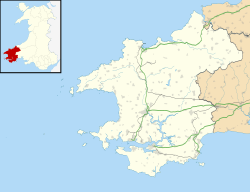For the town in North Wales see: Treffynnon, Sir y Fflint (Holywell, Flintshire)
| Treffynnon | |
|---|---|
 | |
Location within Pembrokeshire | |
| Community | |
| Principal area | |
| Preserved county | |
| Country | Wales |
| Sovereign state | United Kingdom |
| Post town | Haverfordwest |
| Postcode district | SA62 |
| Police | Dyfed-Powys |
| Fire | Mid and West Wales |
| Ambulance | Welsh |
| UK Parliament | |
| Senedd Cymru – Welsh Parliament | |
Treffynnon (Welsh: tref - town + ffynnon - spring, well) is a hamlet of about twenty houses located in the community of Brawdy, between St Davids and Fishguard, about a mile inland from the A487 at Croesgoch in Pembrokeshire.
On the edge of the village stands Treffynnon Chapel, a Welsh Calvinistic Methodist foundation, originally built in 1867 and rebuilt in 1876. [1] Treffynnon has only one named road with the unusual address of Council Houses, a row of six local authority dwellings dating from the 1960s known locally as The Street.
